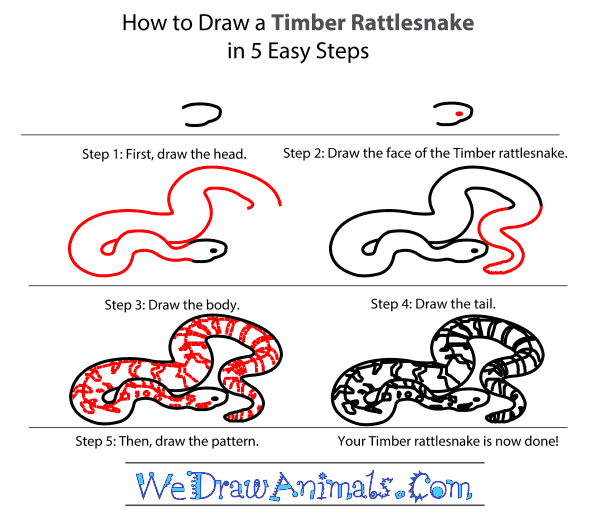In this quick tutorial you'll learn how to draw a Timber Rattlesnake in 5 easy steps - great for kids and novice artists.
The images above represent how your finished drawing is going to look and the steps involved.
Below are the individual steps - you can click on each one for a High Resolution printable PDF version.
At the bottom you can read some interesting facts about the Timber Rattlesnake.
Make sure you also check out any of the hundreds of drawing tutorials grouped by category.
How to Draw a Timber Rattlesnake - Step-by-Step Tutorial
Step 1: Let's begin the timber rattlesnake by drawing the head. Draw a small oval shape.
Step 2: Simply draw a tiny circle for the eye.
Step 3: Now let's draw the body! Our timber rattlesnake has a long, slender, coiled-up body.
Step 4: Draw the bottom part of the body by completing the wavy first part.
Step 5: Finally we can draw the snake's scaly pattern! Draw one long line the length of its body, and smaller curvy lines going down all along the long line.
Interesting Facts about the TIMBER RATTLESNAKE
The Timber Rattlesnake is a member of the reptile family and the scientific term for them is Crotalus horridus. Other common names for this species are the Canebrake Rattlesnake and the Banded Rattlesnake. It is native to eastern United States and is related to the Pit Viper, which is a poisonous snake that contains pitted indentations in its cheeks that access the sinuses for heat detection.
Did you know?
- The animal was first documented in 1758.
- This species became the state reptile of West Virginia in 2008.
- They have poison classifications of A, B, and C.
- The creature can weigh almost 10 pounds.
- They can grow up to over 6 feet long.
These have dark brown or black colored irregular bands on a light brown or grey background. The color and pattern of them serves as camouflage that helps them follow their live food source, but also prevents humans from noticing them before they become bitten, which may be deadly. Pregnant females require a warmer area to increase their metabolism, such as on the edges of the forest where direct sunlight can warm them in a rocky area. There are not many of these creatures, but they are the least concern for a possibility of extinction.






